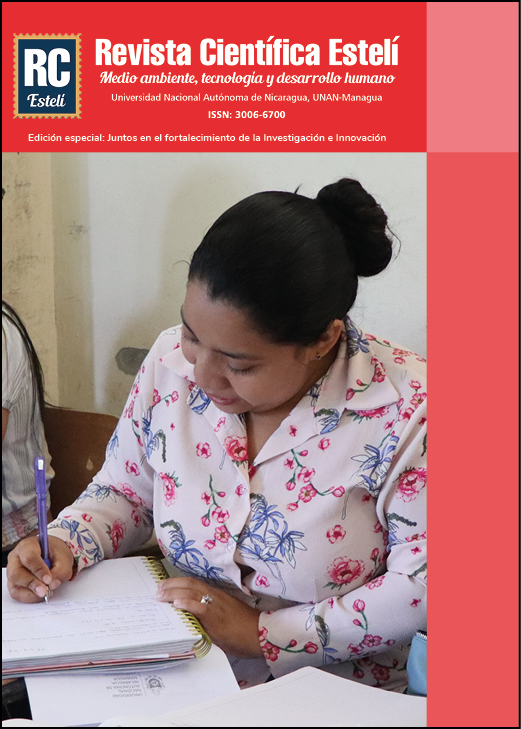Methodological strategies and didactic and pedagogical resources implemented by professors in the subject of Musical Language at UNAN-Managua. Nicaragua
DOI:
https://doi.org/10.5377/esteli.v13i2.19816Keywords:
Methodological strategies, Teaching and learning process, Teaching and didactic resources TICS, Musical language.Abstract
The study carried out at the National Autonomous University of Nicaragua (UNAN-Managua) analyzes the effectiveness of the methodological strategies and didactic resources used by teachers in the subject of Musical Language in the Pedagogy Career with Mention in Musical Education. The main objective is to identify the strategies and resources implemented to strengthen students’ musical reading and writing skills. The research, with a qualitative and cross-sectional approach, included interviews, focus groups and non-participant observations. Six students and five teachers, selected by convenience, participated. Data were collected on the strategies used in teaching reading, writing and vocal tuning. The results showed that traditional methods based on repetition and the use of the piano predominate, with little integration of technological resources such as metronomes, virtual synthesizers and music editing programs. Among the main findings, diverse teaching strategies were identified, but a lack of methodological diversity and a limited use of ICT were highlighted. Students showed difficulties in vocal intonation and score reading, attributed in part to the lack of innovative tools and dynamic methodologies. In addition, classroom infrastructure and teacher training in the use of ICT were found to be critical areas requiring improvement. The conclusions underline the need to diversify methodological strategies and expand the use of technological didactic resources to improve the teaching-learning process of Musical Language. The integration of digital technologies and more dynamic and interactive methods are recommended to enrich the educational experience and foster greater student motivation and participation. The continuous training of teachers in the use of ICT is essential to modernize and make more effective the teaching of Musical Language, thus ensuring more significant and lasting results in the musical education of students.
Downloads
References
Aguirre, O. (1992). Educacion musical: Manual para el profesor . Aljibe.
Anderson, R. C. (1984)). Early literacy: The development of young children’s reading and writing. . Newark: International Reading Association.
Ayats, J. (2000). . Enseñar la música o educar en el ámbito de la música. . Graó.
Bonet, N. .. (1984). Tractat de solfeig I: Introducció als elements essencials de la música. Catalana d’Edicions Musicals.
Calero, D. V. (2014). Seminario Taller de Tesis I y II. UNAN.
Del Bianco, S. &. ( 2007). Aportaciones teóricas y metodológicas a la educación musical. . Graó.
Despins, J. (1994). La música y el cerebro. . Gedisa.
Ferrero, B. (1979). Música para la educación preescolar. . Edelvives.
García, D. J. (2008). Estilos de aprendizaje en el siglo XXI. Estilos de Aprendizaje, .
García, R. (1998). Material didáctico de la UNED. . Aparici.
Gardner, H. (1994). Educación artística y desarrollo humano. Paidós.
Giráldez, A. (2007). La educación musical en un mundo digital. Ufonía. . Didáctica de la Música, Graó. 39.
Hallam, S. (2010). The power of music: Its impact on the intellectual, social and personal development of children and young people. . International Journal of Music Education,.
Hargreaves, A. (2011). Estrategias didácticas, actividad constructiva y creativa del maestro.
Hernández, R. D. (1999). Educación por el arte: Pedagogía contemporánea. Fladem.
LEEME (Lista Europea de Música en la Educación Musical). (1999). (1999). https://www.leeme.org.
Maria, P. F. (2011). Didáctica general: Una perspectiva integradora. . Graó.
Monereo, C. C. (1998). Estrategias de enseñanza y aprendizaje. . Graó.
O.M, A. (1992). Educación musical: Manual para el Profesor . Alije.
Otros, A. J. (1996). Calidad de la educación en el istmo centroamericano. . Norma.
Otros, C. y. (1990). Teoría completa de la música. . Ricordi.
Pascual, P. (2010). Didáctica de la música. . Prentice-Hal.
Pérez-Aldeguer, S. (2014). Tecnologías aplicadas a la educación musical: Una revisión bibliográfica. Revista Electrónica de Investigación Educativa, 16 ((2), 120-135.
Rodríguez Gómez, G. &. (1996). Metodología de la investigación cualitativa. . Aljibe.
Rodríguez Gómez, G. &. (1996). Metodología de la investigación cualitativa. . Aljibe.
Rodríguez-Quiles, J. (2017). Recursos tecnológicos en la formación musical: Usos y aplicaciones. Tinta.
Smith, J. (1983). MIDI: The Musical Revolution.: . Oxford University Press.
Soulage, M. (1977). (1977). Le solfège. . Presses Universitaires de France.
Downloads
Published
Issue
Section
License
Copyright (c) 2024 Revista Científica Estelí

This work is licensed under a Creative Commons Attribution-NonCommercial-ShareAlike 4.0 International License.

